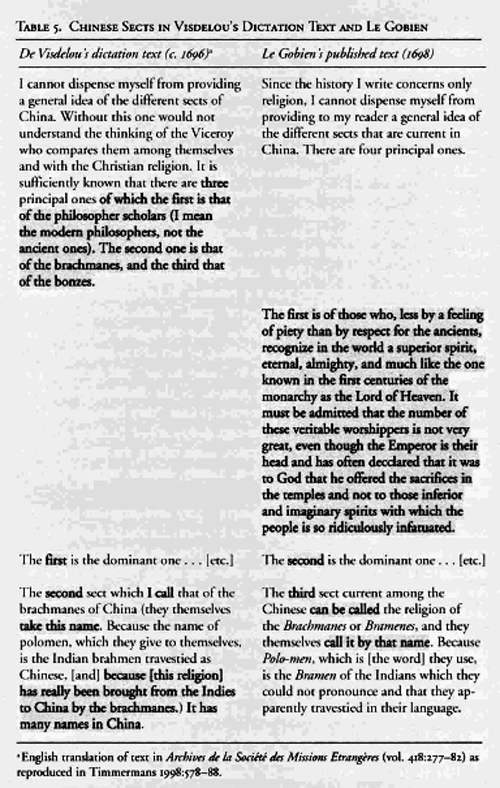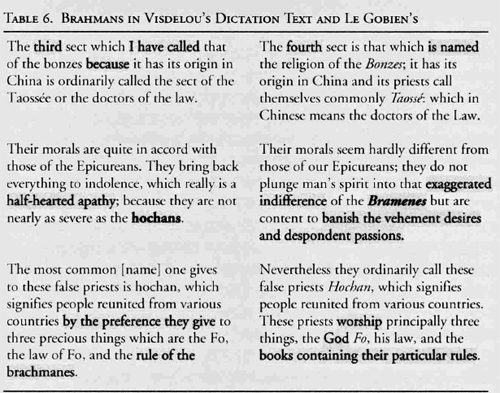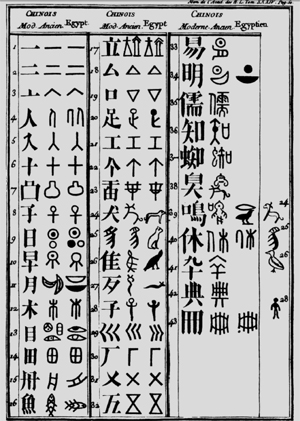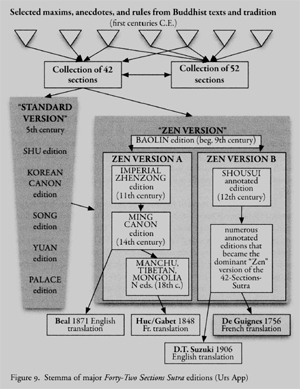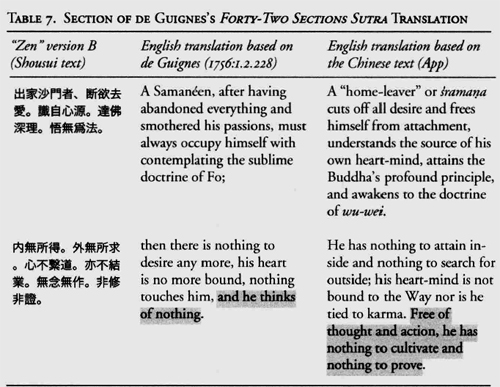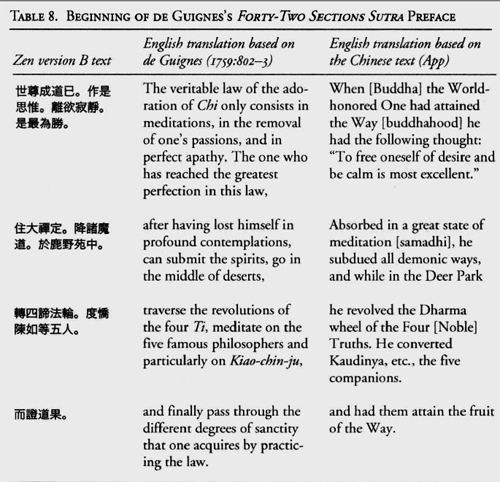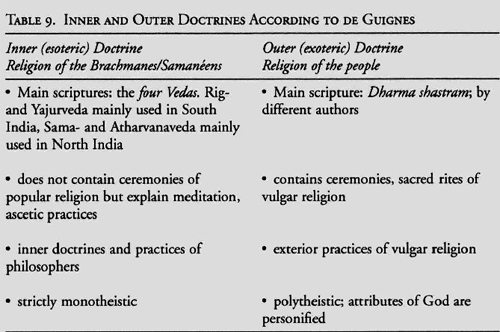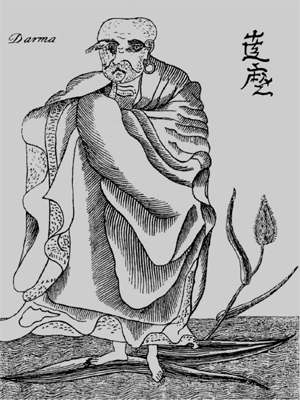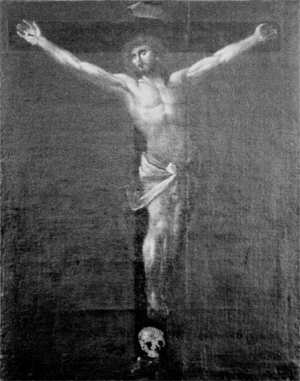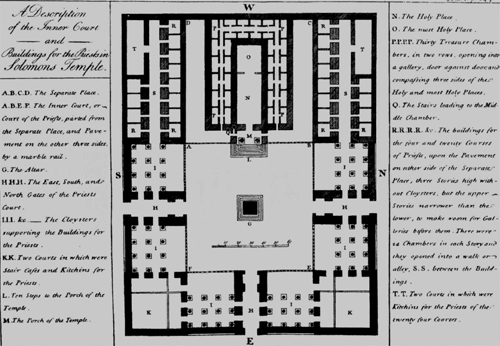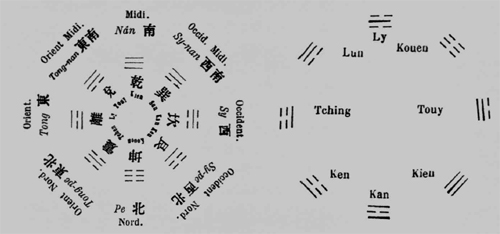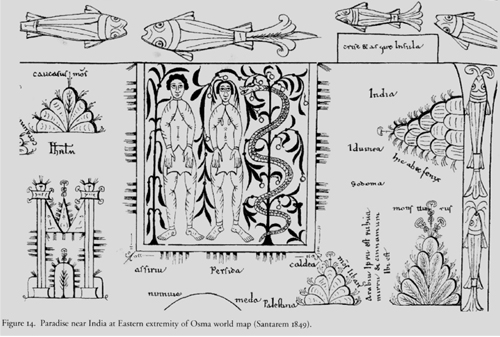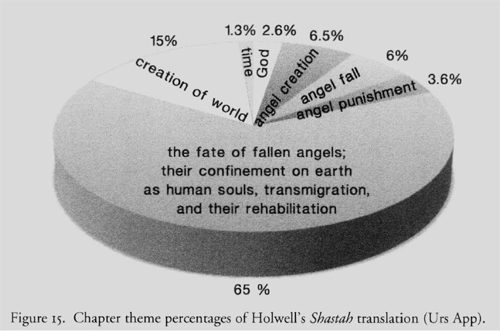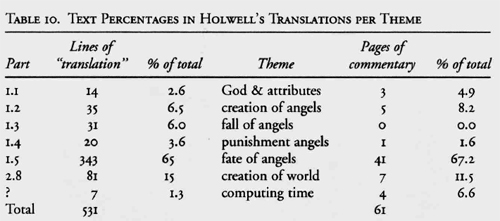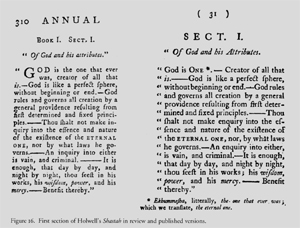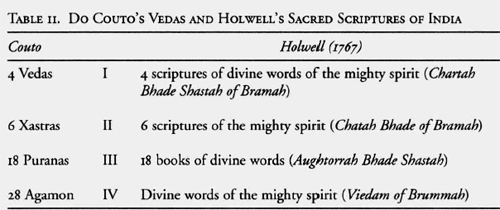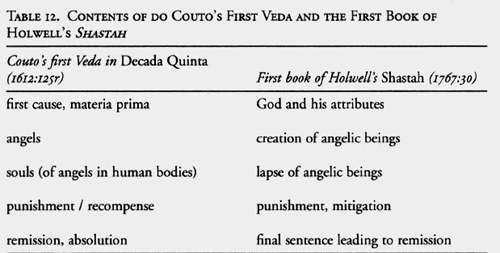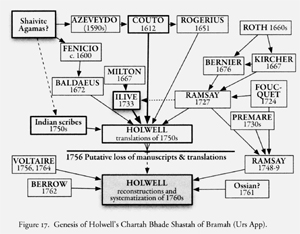Chapter 4: De Guignes's Chinese Vedas
The "invention," "discovery," or identification of major Asian religions (in particular, Hinduism and Buddhism) is often situated in the "longer" nineteenth century during which, as a recent book claims, "the Invention of World Religions" took place. Its author states that toward the end of the nineteenth century Buddhism "had only recently been recognized as 'the same' tradition existing in diverse regions of South, South-east, East, and Central Asia," and that until that time European observers had not ''thought of these divergent rites and widely scattered institutions as constituting a single religion" (Masuzawa 2005:122). The discovery [Lib. Com.: "invention"/"creation"] of Buddhism is characterized as being "from the beginning, in a somewhat literal and nontrivial sense, a textual construction," so much so that "one might say that Buddhism as such came to life, perhaps for the first time, in a European philological workshop" (p. 126). Such arguments are based on several assumptions that merit questioning. We have already seen that the emergence in the European mind of a pan-Asiatic religion (that we now readily identify as Buddhism) did not happen overnight in some nineteenth-century study. Such scenarios of a nineteenth-century "creation" of Buddhism grew on a soil fertilized by several biases. The "Indian" bias links the European discovery [Lib. Com.: "invention"/"creation"] of Buddhism to India as Buddhism's country of origin, the "textual" bias to the study of Buddhist texts in Indian languages, and the "colonialist" bias posits that such discovery [Lib. Com.: "invention"/"creation"] and study were primarily linked to colonial interests. This accounts for the exaggerated role of British "pioneers" in recent studies. Charles Allen's "men who discovered India's lost religion," for example, are without exception British colonialist "Sahibs" (Allen 2002). But even scholars with a much broader perspective suffer from similar biases. For example, J. W. de Jong's Brief History of Buddhist Studies in Europe and America (1997) fails to mention Joao Rodrigues (see our Chapter 1), La Croze (see Chapter 2), and the protagonist of the present chapter, Joseph de Guignes. Even the most informative study to date, Henri de Lubac's La rencontre du bouddhisme et de l'Occident (1952/2000), ignores that de Guignes's 1756 French rendering of the Forty-Two Sections Sutra was the first published translation in a Western language of a Buddhist sutra.
Related to these "Indian" and "Sanskrit" biases is one that pitches "science" against missionary "protoscience." It assumes that the onset of "modern" Orientalism in the first decades of the nineteenth century was a clean break from the "missionary" past. The pre-nineteenth-century discovery [Lib. Com.: "invention"/"creation"] of Buddhism is thus divorced from its "scientific discovery [Lib. Com.: "invention"/"creation"] and the latter is portrayed as a "new start from almost nothing" (Droit 1997:29). Unlike the installation of a new operating system on a computer, which guarantees at least some continuity of data, Droit regards this new start as a total break with the past and generalizes: "It is a permanent feature of the West's relation with the doctrines of Buddhism that, in the very long run, information does not accumulate" (p. 29). For Droit, the decisive "new start" and thus Buddhism's discovery [Lib. Com.: "invention"/"creation"] in the proper sense" only happened "from the moment when the languages of its canonical scriptures were deciphered and the fundamental texts translated in a systematic manner" (p. 36). When did this happen, and what languages were in play? Droit explains:
Now, even though Sanskrit had been known since the 1780s, the Buddhist treatises in Sanskrit were only discovered during the 1820s in Nepal by Brian Houghton Hodgson; Pali was only deciphered by Eugene Burnouf and Christian Lassen during the same period; and the Chinese Buddhist texts were only at this moment studied by Jean-Pierre Abel-Remusat, who was soon followed by the Hungarian Alexander Csoma de Koros's study of Tibetan. (p. 36)
If such bias is combined with constructivism, the 1820s become the "turning point" that "led Europe from ignorance to knowledge" and the crucial moment when the word "Buddhism" and the "phenomenon itself" were simultaneously "born in the scholarly gaze" (p. 36). In contrast to such a clean-cut birth by Caesarian section in the lecture halls of state-sponsored Orientalist academia, we have seen that the discovery [Lib. Com.: "invention"/"creation"] of a large Asian religion with a specific founder, history, geographical presence, body of teachings, and sacred texts was a rather messy and protracted event that began long before the moment in the 1820s when European scholars began to read Sanskrit and Pali Buddhist texts. Contrary to Droit's assertion, much information gradually accumulated over several centuries, and the permanent feature of the West's relation with Buddhism was that information, once it was collected or invented, was rarely forgotten but rather tended to be endlessly repeated and widely accepted. The above-mentioned Story of the Buddha's deathbed confession is a perfect illustration of this phenomenon. Moreover, Buddhist texts were studied and even translated long before Sanskrit entered the picture. To mention just a few examples: in 1574 the Jesuit Japan missionaries Organtino Gnecchi-Soldo and Luis Frois devoted two hours per day to the study of the Chinese text of the Lotus Sutra under the guidance of a former Buddhist abbot and persisted for a whole year (Frois 1926:452); the first partial translation of a Buddhist text from Pali was published by Simon de la Loubere in 1691; Ippolito Desideri studied and translated Tibetan Buddhist texts in the early eighteenth century; and the first Buddhist sutra to be published in Europe, the Forty-Two Sections Sutra, was translated by de Guignes from the Chinese in the 1750s. All of this happened long before Europeans became aware of Buddhist Sanskrit texts.
The European obsession with origins and Bible-like canonical texts contributed to the bias for India, Sanskrit, and Pali. However -- just like wars -- discoveries happen as they actually do and not as one might wish they should; and it is a matter of historical fact that Sanskrit entered the stage rather late. But a fundamentalist obsession with "genuine" Buddhist "bibles" from India led from the late nineteenth century to the view that the Buddhisms of distant countries such Japan, China, and Tibet are "degenerate" and their texts incomparably inferior to those of mother India. It is as if researchers of Christianity would regard Roman Catholicism or Syriac orthodoxy as degenerate and inferior because they are removed from Christianity's Aramaic and Greek origins. When European missionaries ventured to Asia, Buddhism had long vanished from India and flourished in distant countries such as Mongolia, Japan, China, Tibet, Siam, Burma, Cambodia, Ceylon, Vietnam, and Laos. To no one's surprise, these were exactly the countries where the Europeans discovered [Lib. Com.: "invention"/"creation"] Buddhism, and de Guignes is an excellent example for the impact of literature from such non-Indian countries. The discovery [Lib. Com.: "invention"/"creation"] of long-vanished Indian Buddhism, by contrast, indeed happened to a large extent in the nineteenth-century "European philological workshop" (Masuzawa 2005:126). The present chapter will show, however, that prior to that there were "workshops" not manned by Sanskritists but rather by French missionaries and by academics who studied and translated Arabic and Chinese sources long before the first British colonialists began to dabble in Sanskrit.1
Fourmont's Dirty Little Secret
When Joseph DE GUIGNES (1721-1800) at the young age of fifteen was placed with Etienne FOURMONT (1683-1745), Fourmont enjoyed a great reputation as one of Europe's foremost specialists of classical as well as oriental languages. As an associate of Abbe Bignon (the man so eager to stock the Royal Library with Oriental texts), Fourmont had met a Chinese scholar called Arcadius HOANG (1679-1716) and had for a short while studied Chinese with him (Elisseeff 1985:133ff.; Abel-Remusat 1829:1.260). In 1715 the thirty-two-year-old Fourmont was elected to the chair of Arabic at the College Royal. Hoang's death in 1716 did not diminish Fourmont's desire to learn Chinese, and in 1719 he followed Nicolas FRERET (1688-1749) in introducing Europe to the 214 Chinese radicals. This is one of the systems used by the Chinese to classify Chinese characters and to make finding them, be it in a dictionary or a printer's shop, easier and quicker.
Thanks to royal funding for his projected grammar and dictionaries, Fourmont had produced more than 100,000 Chinese character types. But in Fourmont's eyes the 214 radicals were far more than just a classification method. Naming them "clefs" (keys), he was convinced that they were meaningful building blocks that the ancient Chinese had used in constructing characters. For example, Fourmont thought that the first radical (-) is "the key of unity, or priority, and perfection" and that the second radical (׀) signifies "growth" (Klaproth 1828:234). Starting with the 214 basic "keys," so Fourmont imagined, the ancient Chinese had combined them to form the tens of thousands of characters of the Chinese writing system. However, as Klaproth and others later pointed out, the Chinese writing system was not "formed from its origin after a general system"; rather, it had evolved gradually from "the necessity of inventing a sign to express some thing or some idea." The idea of classifying characters according to certain elements arose only much later and resulted in several systems with widely different numbers of radicals ranging from a few dozen to over 700 (Klaproth 1828:233-36).
Like many students of Chinese or Japanese, Fourmont had probably memorized characters by associating their elements with specific meanings. A German junior world champion in the memory sport, Christiane Stenger, employs a similar technique for remembering mathematical equations. Each element is assigned a concrete meaning; for example, the minus sign signifies "go backward" or "vomit," the letter A stands for "apple," the letter B for "bear," the letter C for "cirrus fruit," and the mathematical root symbol for a root. Thus, "B minus C" is memorized by imagining a bear vomiting a citrus fruit, and "minus B plus the root of A square" may be pictured as a receding bear who stumbles over a root in which a square apple is embedded.
Stenger's technique, of course, has no connection whatsoever to understanding mathematical formulae, but Fourmont's "keys" can indeed be of help in understanding the meaning of some characters. While such infusion of meaning certainly helped Fourmont and his students Michel-Ange-Andre le Roux DESHAUTERAYES (1724-95) and de Guignes in their study of complicated Chinese characters, it also involved a serious misunderstanding. Stenger understood that bears and fruit were her imaginative creation in order to memorize mathematical formulae and would certainly not have graduated from high school if she had thought that her mathematics teacher wanted to tell her stories about apples and bears.
But mutatis mutandis, this was exactly Fourmont's mistake. Instead of simply accepting the 214 radicals as an artificial system for classifying Chinese characters and as a mnemonic aide, he was convinced that the radicals are a collection of primeval ideas that the Chinese used as a toolset to assemble ideograms representing objects and complex ideas. Fourmont thought that the ancient Chinese had embedded a little story in each character. As he and his disciples happily juggled with "keys," spun stories, and memorized their daily dose of Chinese characters, they did not have any inkling that this fundamentally mistaken view of the genesis of Chinese characters would one day form the root for a mistake of such proportions that it would put de Guignes's entire reputation in jeopardy.
Apart from a series of dictionaries that never came to fruition, Fourmont was also working on a Chinese grammar. He announced its completion in 1728, eight years before the arrival of de Guignes. The first part of this Grammatica sinica with Fourmont's presentation of the 214 "keys" and elements of pronunciation appeared in 1737. The second part, prepared for publication while de Guignes sat at his teacher's feet, contained the grammar proper as well as Fourmont's catalog of Chinese works in the Bibliotheque Royale and was published in 1742. When Fourmont presented the result to the king of France, he had de Guignes accompany him, and the king was so impressed by the twenty-one-year-old linguistic prodigy that he endowed him on the spot with a pension (Michaud 1857:18.126).
Work on the Chinese language
Helped by the young Nicolas Fréret (1688–1749), he began the hard work of pioneering a Chinese-French dictionary, a Chinese grammar, employing the Kangxi system of 214 character keys.
In this work, they were joined by Nicolas Joseph Delisle (1683–1745), a friend of Fréret, who gave a more cultural and geographical tone to their work and discussions. Deslisle's brother, Guillaume Delisle, was already a renowned geographer. Delisle encouraged Arcadio Huang to read Europe's best known and popular writings dealing with the Chinese Empire. Huang was surprised by the ethnocentric approach of these texts, reducing the merits of the Chinese people and stressing the civilizing role of the European peoples.
A third apprentice, by the name of Étienne Fourmont (imposed by Abbé Bignon), arrived and profoundly disturbed the team. One day, Fourmont was surprised copying Huang's work.
Debate after his death
After the death of Huang on 1 October 1716, Fourmont became officially responsible for classifying papers of the deceased. He made a very negative report on the contents of these documents and continued to criticize the work of Huang. Continuing his work on the languages of Europe and Asia (and therefore the Chinese), he took all the credit for the dissemination of the 214 key system in France, and finally published a French-Chinese lexicon and a Chinese grammar, without acknowledging the work of Huang, whom he was continuing to denigrate publicly.
-- Arcadio Huang, by Wikipedia
But de Guignes's teacher Fourmont had a dirty little secret. He had focused on learning and accumulating data about single Chinese characters, but his knowledge of the Chinese classical and vernacular language was simply not adequate for writing a grammar. By consequence, the man who had let the world know that a genius residing in Europe could master Chinese just as well as the China missionaries decided to plagiarize -- what else? -- the work of a missionary. No one found out about this until Jean-Pierre Abel-Remusat in 1825 carefully compared the manuscript of the Arte de La lengua mandarina by the Spanish Franciscan Francisco Varo with Fourmont's Latin translation and found to his astonishment that Fourmont's ground-breaking Grammatica sinica was a translation of Varo's work (Abel-Remusat 1829:2.298). In an "act of puerile vanity," Abel-Remusat sadly concluded, Fourmont had appropriated Varo's entire text "almost without any change" while claiming that he had never seen it (1826:2.109).2
While de Guignes helped prepare this grammar for publication, Fourmont continued his research on chronology and the history of ancient peoples. During the seventeenth century, ancient Chinese historical sources had become an increasingly virulent threat to biblical chronology and, by extension, to biblical authority. As Fourmont's rival Freret was busy butchering Isaac Newton's lovingly calculated chronology, de Guignes's teacher turned his full attention to the Chinese annals. These annals were in general regarded either as untrustworthy and thus inconsequential or as trustworthy and a threat to biblical authority. However, in a paper read on May 18, 1734, at the Royal Academy of Inscriptions, Fourmont declared with conviction that he could square the circle: the Chinese annals were trustworthy just because they confirmed the Bible.
The Square within the Circle [is one of] the most potent of all the magical figures.
--The Secret Doctrine: The Synthesis of Science, Religion, and Philosophy, by Helena Petrovna Blavatsky
***
"As the sky with its stars and constellations is nothing separate from the All but includes the All, so is the 'firmament' of Man not separate from Man; and as the Universal Mind is not ruled by any external being, likewise the firmament in Man (his individual sphere of mind) is not subject to the rule of any creature, but is an independent and powerful whole." -- This fundamental truth of occultism is allegorically represented in the interlaced double triangles. He who has succeeded in bringing his individual mind in exact harmony with the Universal Mind has succeeded in reuniting the inner sphere with the outer one, from which he has only become separated by mistaking illusions for truths. He who has succeeded in carrying out practically the meaning of this symbol has become one with the father; he is virtually an adept, because he has succeeded in squaring the circle and circling the square. All of this proves that Paracelsus has brought the root of his occult ideas from the East.
-- The Life of Philippus Theophrastus Bombast of Hohenheim Known by the Name of Paracelsus and the Substance of his Teachings, by Franz Hartmann, M.D.
***
Our scientific procedure is obviously the negation of the Absolute. That was an acute and happy remark of Goethe's: "He who devotes himself to nature attempts to find the squaring of the circle."
-- The Foundations of the Nineteenth Century, by Houston Stewart Chamberlain
***
The geometrician does not know the square of the circle.
-- De Monarchia of Dante Alighieri
***
It is impossible to square the circle perfectly because of its arc.
-- The Convivio, by Dante Alighieri
***
Arnesen proclaimed in a firm voice that all of the challenges in aquaculture would be mastered, including the biggest one of all: how to convert salmon to vegetarianism? The carnivorous predator fish need large amounts of animal protein. The feed concentrate dumped into the cages by the ton is made mainly of fishmeal and fish oil. It's a negative cycle: 4-6 kilograms of wild fish are killed and made into meal to produce one kilo of salmon flesh. More than half of the world's fish catch now goes to making feed concentrate for salmon and other animals. Farm-bred salmon consume more animal protein than they produce. How can that be sustainable? "We see the problem the same way the WWF does," conceded Petter Arnesen. "We're experimenting with increasing the share of vegetable protein in the feed, using soy, for example." The company was determined to achieve this, he said, as the fish reserves of the world's oceans were already "exhausted". The trouble is, when there is too little fish product in the feed the salmon raised on it no longer contain as much healthy omega 3 fatty acids. That's not the kind of salmon the retailers want. The poor Technical Director has the daunting task of circling the square -- luckily the WWF can lend him a hand: by simply designating the whole thing "sustainable".
-- Panda Leaks: The Dark Side of the WWF, by Wilfried Huismann
***
Although the CIA knew that the estimated 120,000 VC Self-Defense Forces (which Westmoreland described as "old men, old women and children") were the integral element of the insurgency, Carver, after being shown "evidence that I hadn't heard before," cut a deal on September 13. He sent a cable to Helms saying: "Circle now squared .... We have agreed set of figures Westmoreland endorsed." In November National Security Adviser Walt Rostow showed President Johnson a chart indicating that enemy strength had dropped from 285,000 in late 1966 to 242,000 in late 1967. President Johnson got the success he wanted to show, and Vietnam got Tet.
-- The Phoenix Program, by Douglas Valentine
Dismissing Freret's and Newton's nonbiblical Middle Eastern sources as "scattered scraps," he praised the Chinese annals to the sky as the only ancient record worth studying apart from the Bible (Fourmont 1740:507-8).
But Fourmont's lack of critical acumen is as evident in this paper as in his Critical reflections on the histories of ancient peoples of 1735 and the Meditationes sinicae of 1737. In the "avertissement" to the first volume of the Critical reflections, Fourmont mentions the question of an India traveler, Chevalier Didier, who had conversed with Brahmins and missionaries and came in frustration to Paris to seek Fourmont's opinion about an important question of origins: had Indian idolatry influenced Egyptian idolatry or vice versa? Fourmont delivered his answer after nearly a thousand tedious pages full of chronological juggling:
With regard to customs in general, since India is entirely Egyptian and Osiris led several descendants of Abraham there, we have the first cause of that resemblance of mores in those two nations; but with regard to the religion of the Indians, they only received it subsequently through commerce and through the colonies coming from Egypt. (Fourmont 1735:2-499)
For Fourmont the Old Testament was the sole reliable testimony of antediluvian times, and he argued that the reliability of other accounts decreases with increasing distance from the landing spot of Noah's ark. Only the Chinese, whose "language is the oldest of the universe," remain a riddle, as their antiquity "somehow rivals that of Genesis and has caused the most famous chronologists to change their system" (1735:1.lii). But would not China's "hieroglyphic" writing system also indicate Egyptian origins? Though Fourmont suspected an Egyptian origin of Chinese writing, he could not quite figure out the exact mechanism and transmission. He suspected that "Hermes, who passed for the inventor of letters" had not invented hieroglyphs but rather "on one hand more perfect hieroglyphic letters, which were brought to the Chinese who in turn repeatedly perfected theirs; and on the other hand alphabetic letters" (Fourmont 1735:2.500). These "more perfect hieroglyphs" that "seemingly existed with the Egyptian priests" are "quite similar to the Chinese characters of today" (p. 500).
Fourmont was studying whether there was any support for Kircher's hypothesis that the letters transmitted from Egypt to the Chinese were related to Coptic monosyllables (p. 503); but though he apparently did not find conclusive answers to such questions, the problem itself and Fourmont's basic direction (transmission from Egypt to China, some kind of more perfect hieroglyphs) must have been so firmly planted in his student de Guignes's mind that it could grow into the root over which he later stumbled. Fourmont's often repeated view that Egypt's culture was not as old as that of countries closer to the landing spot of Noah's ark made it clear that those who regarded Egypt as the womb of all human culture were dead wrong and that China, in spite of its ancient culture, was a significant step removed from the true origins.
Though the Chinese had received their writing system and probably also the twin ideas that in his view "properly constitute Egyptianism" -- the idea of metempsychosis and the adoration of animals and plants (p. 492) -- Fourmont credited the Chinese with subsequent improvements also in this respect: "My studies have thus taught me that the Chinese were a wise people, the most ancient of all peoples, but the first also, though idolatrous, that rid itself of the mythological spirit" (Fourmont 1735:2.liv). This accounted for their excellent historiography and voluminous literature:
I said that the Chinese Annals can be regarded as a respectable work. First of all, as everybody admits, for more than 3,500 years China has been populated, cultivated, and literate. Secondly, has it lacked authors as its people still read books, though few in number, written before Abraham? Thirdly, since few scholars know the Chinese books, let me here point out that the Chinese Annals are not bits and pieces of histories scattered here and there like the Latin and Greek histories which must be stitched together: they consist of at least 150 volumes that, without hiatus and the slightest interruption, present a sequence of 22 families which all reigned for 3, 4, 8, 10 centuries. (p. liv)
While Fourmont cobbled together hypotheses and conjectures, the Bible always formed the backdrop for his speculations about ancient history. A telling example is his critique of the Chinese historian OUYANG Xiu (1007-72), who argued that from the remote past, humans had always enjoyed roughly similar life spans. Lambasting this view as that of a "skeptic," Fourmont furnished the following argument as "proof" of the reliability of ancient Chinese histories:
We who possess the sacred writ: must we not on the contrary admire the Chinese annals when they, just in the time period of Arphaxad, Saleh, Heber, Phaleg, Rea, Sarug, Nachor, Abraham, etc., present us with men who lived precisely the same number of years? Now if someone told us that Seth at the age of 550 years married one of his grand-grand-nieces in the fourteenth generation: who of us would express the slightest astonishment? ... It is thus clear that all such objections are frivolous, and furthermore, that attacks against the Chinese annals on account of a circumstance [i.e., excessive longevity] which distinguishes them from all other books will actually tie them even more to Scripture and will be a sure means to increase their authority. (Fourmont 1740:514)
No comment is needed here.[???]
Immediately after Fourmont's death in 1745, the twenty-four-year-old Joseph de Guignes replaced his master as secretary interpreter of oriental languages at the Royal Library. It was the beginning of an illustrious career: royal censor and attache to the journal des Scavans in 1752, member of the Academie des Inscriptions et Belles-Lettres in 1753, chair of Syriac at the College Royal from 1757 to 1773, garde des antiques at the Louvre in 1769, editor of the Journal des Savants, and other honors (Michaud 1857:18.(27). De Guignes had, like his master Fourmont, a little problem. The pioneer Sinologists in Paris were simply unable to hold a candle to the China missionaries. Since 1727 Fourmont had been corresponding with the figurist China missionary Joseph Henry PREMARE (1666-1736), who, unlike Fourmont, was an accomplished Sinologist (see Chapter 5). Premare was very liberal with his advice and sent, apart from numerous letters, his Notitia Linguae sinicae to Fourmont in 1728. This was, in the words of Abel-Remusat,
neither a simple grammar, as the author too modestly calls it, nor a rhetoric, as Fourmont intimated; it is an almost complete treatise of literature in which Father Premare not only included everything that he had collected about the usage of particles and grammatical rules of the Chinese but also a great number of observations about the style, particular expressions in ancient and common idiom, proverbs, most frequent patterns -- and everything supported by a mass of examples cited from texts, translated and commented when necessary. (Abel-Remusat 1829:2.269)
Premare thus sent Fourmont his "most remarkable and important work," which was "without any doubt the best of all those that Europeans have hitherto composed on these matters" (p. 269).
But instead of publishing this vastly superior work and making the life of European students of Chinese considerably easier, Fourmont compared it unfavorably to his own (partly plagiarized) product and had Premare's masterpiece buried in the Royal Library, where it slept until Abel-Remusat rediscovered it in the nineteenth century (pp. 269-73). However, Fourmont's two disciples Deshauterayes and de Guignes could profit from such works since Fourmont for years kept the entire China-related collection of the Royal Library at his home where the two disciples had their rooms; thus Premare was naturally one of the Sinologists who influenced de Guignes.4 So was Antoine GAUBIL (1689-1759), whose reputation as a Sinologist was deservedly great.
But there is a third, extremely competent Jesuit Sinologist who remained in the shadows, though his knowledge of Chinese far surpassed that of de Guignes and all other Europe-based early Sinologists (and, one might add, even many modern ones). His works suffered a fate resembling that of the man who was in many ways his predecessor, Joao Rodrigues (see Chapter 1) in that they were used but rarely credited. The man in question was Claude de VISDELOU (1656-1737), who spent twenty-four years in China (1685-1709) and twenty-eight years in India (1709-37). One can say without exaggeration that the famous Professor de Guignes owed this little-known missionary a substantial part of his fame -- and this was his dirty little secret.
De Visdelou's Brahmins
The fact that the reader has already encountered one of de Visdelou's seminal ideas without realizing it is symptomatic. De Visdelou was the direct source of Le Gobien's "Brahmin followers of Fo" mixup that reached, as we have seen in the previous chapter, such a large European readership via Bayle's and Diderot's "Brachmanes" articles. After his arrival in China in 1685, the linguistically gifted Frenchman made such fast progress in learning Chinese that even China's crown prince was astonished. In a letter dated January 20, 1728, De Visdelou remembers a scene from the year 1790:
When I was five years in China and had begun to devote myself to reading Chinese books for barely four years, emperor Kangxi ordered me and one of my companions to come from Canton to Beijing. We were directly led to the palace. The emperor was gravely ill, and we could not see him. The crown prince of the empire who conducted affairs in place of his father was told that a European had arrived who within four years had acquired knowledge of the canonical books and the classics. The prince soon appeared at the door asking where that foreigner was. Here he is, I answered, after I had prostrated in the manner of the land. The prince immediately ordered that a volume of the canonical book called Shujing be brought, i.e., the Canonical History. Opening it at random, he asked me to stand up and read it; I did so and explained it in the presence of several persons who accompanied the prince. Since the Chinese have a high opinion of themselves and their products, the prince was in admiration and said the following words: "Ta-ting, i.e., he understands very well."[???] The crown prince did not leave it at this verbal testimony but also wanted to provide an authentic attestation, written in Chinese characters on a piece of satin one aune in length and half an aune in width. It said: "We recognize that this man from Europe is loftier in intelligence [lumiere] and in the knowledge of Chinese characters than the clouds floating above our heads, and that he is more profound in penetration and knowledge than the abyss on which we tread." [?another forgery?] (de Visdelou 1760:341-42)
Seven years after this incident, de Visdelou dictated a few pages about the religions of China to the visiting Mr. Basset in order to explain the background of a regional persecution of Christians. Basset's notes made their way to Paris and into the hands of Father Le Gobien who edited and used them as introduction to his book about the edict of tolerance issued by the Chinese emperor (1698), which was then used by Bayle and Diderot. Already the first few lines show the extent and character of Le Gobien's editorial interference. He was an inclusivist in the line of Matteo Ricci who shared the opinion of the vast majority of Jesuits that the ancient religion of China (and Confucianism as its successor) had venerated the true God. De Visdelou, by contrast, was one of the few dissenters in the line of Joao Rodrigues who thought that ancient Chinese religion and Confucianism were forms of atheism. Already the initial paragraphs of de Visdelou's report as taken down by Basset were heavily edited by Le Gobien and exhibit an immense difference of opinion. De Visdelou only discussed modern Confucianism, Buddhism, and Daoism and lost no word about an ancient Chinese monotheism. The latter was added by Le Gobien, who claimed that this ancient Confucianism was still extant with the Chinese emperor as head; see Table 5, where major differences are highlighted in gray.
TABLE 5. CHINESE SECTS IN VISDELOU'S DICTATION TEXT AND LE GOBIENDe Visdelou's dictation text (c. 1696) [a]
I cannot dispense myself from providing a general idea of the different sects of China. Without this one would not understand the thinking of the Viceroy who compares them among themselves and with the Christian religion. It is sufficiently known that there are three principal ones of which the first is that of the philosopher scholars (I mean the modern philosophers, not the ancient ones). The second one is that of the brachmanes, and the third that of the bonzes.
The first is the dominant one [!!!] ... [etc.]
The second sect which I call that of the brachmanes of China (they themselves take this name. Because the name of polomen, which they give to themselves, is the Indian brahmen travestied as Chinese, [and] because [this religion] has really been brought from the Indies to China by the brachmanes.) It has many names in China.Le Gobien's published text (1698)
Since the history I write concerns only religion, I cannot dispense myself from providing to my reader a general idea of the different sects that are current in China. There are four principal ones.
The first is of those who, less by a feeling of piety than by respect for the ancients, recognize in the world a superior spirit, eternal, almighty, and much like the one known in the first centuries of the monarchy as the Lord of Heaven. It must be admitted that the number of these veritable worshippers is not very great, even though the Emperor is their head and has often declared that it was to God that he offered the sacrifices in the temples and not to those inferior and imaginary spirits with which the people is so ridiculously infatuated.
The second is the dominant one ... [etc.]
The third sect current among the Chinese can be called the religion of the Brachmanes or Bramenes, and they themselves call it by that name. Because Polomen, which is [the word] they use, is the Bramen of the Indians which they could not pronounce and that they apparently travestied in their language.
a. English translation of text in Archives de La Societe des Missions Etrangeres (vol. 418:277-82) as reproduced in Timmermans 1998:578-88.
Leaving aside the missionary's discussion of Neoconfucianism (de Visdelou's first and Le Gobien's second religion), we will here focus on the passages that for the first time provided support from the Chinese side for Kircher's idea that the Brahmins were the missionaries who brought Xaca's religion from India to China. Though Basset, who wrote down the text dictated by de Visdelou, appears to have left out a few words, the overall meaning of de Visdelou's statement is clear: it is de Visdelou who calls this "sect" that "has many names in China" by the name of "brachmanes of China." In the parentheses he adduces two reasons to justify his choice: (1) its representatives call themselves polomen, which is the Chinese pronunciation of brahmin; and (2) this religion was brought from the Indies to China by the brachmanes. Today we know that boluomen seng (Brahmin monk) was mainly used for Buddhist monks who had come from India to China and that on some occasions it served as a generic honorific for monks (as the Italian "monsignore" would flatter Catholic priests of any country). De Visdelou's choice to call Chinese Buddhism "the sect of the brachmanes of China" was not based on Chinese custom but rather on the Western idea, popular since the publication of Kircher's China illustrata (1667), that the religion of Xaca/Fo (that is, Buddhism) had been brought to China by Brahmins. In fact, after the parentheses explaining his reasons for this choice, de Visdelou clearly states that this religion "has many names in China" and that its priests are commonly called hochan (Ch. heshang, reverend) and not polomen. In Le Gobien's published text, de Visdelou's "I call" becomes "can be called," and de Visdelou's choice turns into an official nomenclature since "they themselves call it by this name." Under Le Gobien's pen, de Visdelou's "sect of the brachmanes of China" loses both the "of China" and its "many names" and turns straight into Brahmanism by becoming "the religion of the Brachmanes or Bramenes" -- and there can be no doubt about this since "they themselves call it by that name." These changes might be regarded as minor, but they are not. As the explanations continue, de Visdelou keeps calling the priests of this religion by the name they use themselves, namely, hocham, whereas Le Gobien changed this into Bramenes.
This was not de Visdelou's (or Basset's?) only confusing sect name; he called his third religion (which we now call Daoism) the sect of the "bonzes," a term usually employed for Buddhist priests. Here, de Visdelou once more emphasizes that this is his choice rather than that of the Daoists, and in the first section of Table 6 he justifies this by pointing once more to the origin of the "sect" (which in this case is China).
De Visdelou's hochans are transformed by Le Gobien into Bramenes, and this choice of words contributed to the "mixup" that filled the critics of Bayle and Diderot with so much indignation. But Le Gobien's confusion is understandable. As the second section of Table 6 shows, de Visdelou seems to have held that the religion brought by brachmanes from India to China has priests called hochan, and that hochan from different countries venerate three identical treasures: Buddha, dharma, and "the rule of the brachmanes."

